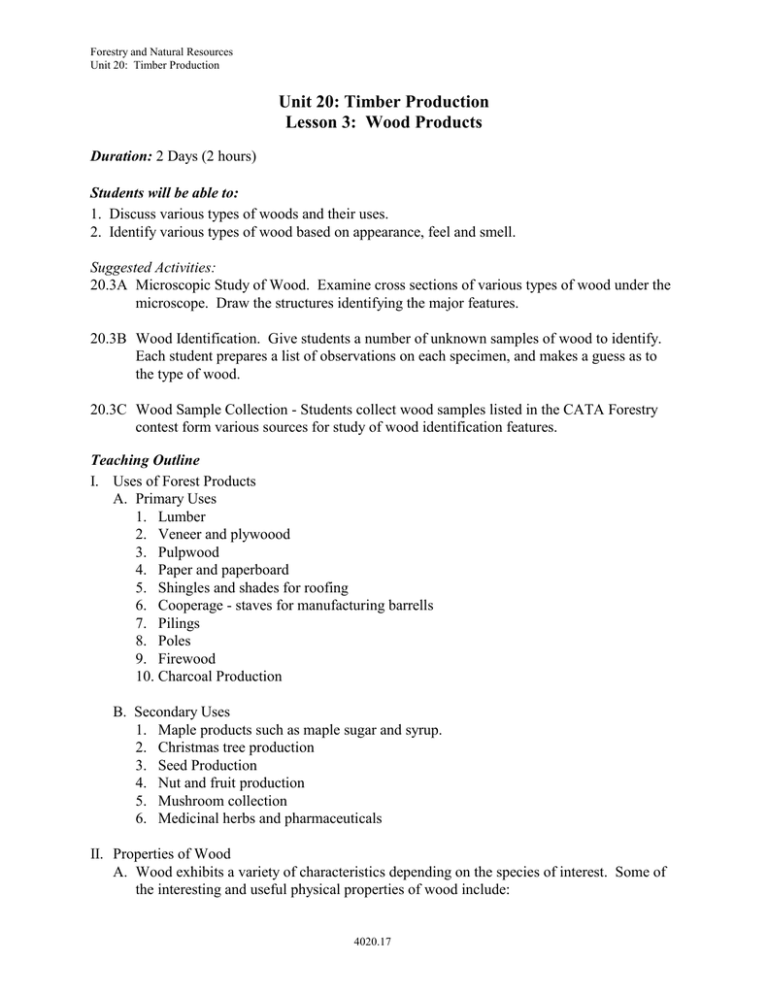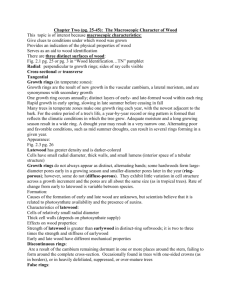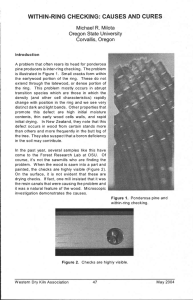Lesson 3 Wood Products
advertisement

Forestry and Natural Resources Unit 20: Timber Production Unit 20: Timber Production Lesson 3: Wood Products Duration: 2 Days (2 hours) Students will be able to: 1. Discuss various types of woods and their uses. 2. Identify various types of wood based on appearance, feel and smell. Suggested Activities: 20.3A Microscopic Study of Wood. Examine cross sections of various types of wood under the microscope. Draw the structures identifying the major features. 20.3B Wood Identification. Give students a number of unknown samples of wood to identify. Each student prepares a list of observations on each specimen, and makes a guess as to the type of wood. 20.3C Wood Sample Collection - Students collect wood samples listed in the CATA Forestry contest form various sources for study of wood identification features. Teaching Outline I. Uses of Forest Products A. Primary Uses 1. Lumber 2. Veneer and plywoood 3. Pulpwood 4. Paper and paperboard 5. Shingles and shades for roofing 6. Cooperage - staves for manufacturing barrells 7. Pilings 8. Poles 9. Firewood 10. Charcoal Production B. Secondary Uses 1. Maple products such as maple sugar and syrup. 2. Christmas tree production 3. Seed Production 4. Nut and fruit production 5. Mushroom collection 6. Medicinal herbs and pharmaceuticals II. Properties of Wood A. Wood exhibits a variety of characteristics depending on the species of interest. Some of the interesting and useful physical properties of wood include: 4020.17 Forestry and Natural Resources Unit 20: Timber Production 1. Biodegradable and renewable resource. 2. Workability - most woods are easily worked with sharp tools. 3. Bending Strength - the flexibily of wood makes it useful for sporting equipment (bats, hockey sticks etc.), and for use as a variety of tool handles. Hickory and ash are often used. 4. Some woods are highly resistant to decay such as cedar and redwood. Hence they make good posts. 5. Insulation - most woods are good insulators 6. Resonance - certain woods are used to make musical insturments 7. Resistance to Shock - wood is used to make mallet heads and bridge timbers. 8. Coloration - the beauty of the color and grain of many woods make them unparalleled for decoration. 9. Some woods are highly flexible and can be bent into permanent forms as with some furniture. 10. Odor - the smell of fresh cut wood is very inviting. Cedar emits smell that deters moths. B. Chemical Properties of Wood 1. Generally slow to combust compared to some other materials. 2. Generally resistant to damage by acids and alkalis. 3. Can contain oils useful in various processes and for creating odorizers. III. Identifying Types of Wood A. Types of Wood 1. Softwoods - cone bearing trees, needles or scale-like leaves, gymnosperms. Wood is not porous, not containing visible vessels or pores. Used to produce lumber for construction. Includes pines, firs, hemlocks, spruce, and cedars. 2. Hardwoods - broadleafed trees, angiosperms, porous woods, containing vessels. Used for cabinet making and fancy woodwork. Includes oak, hickory, maple, walnut and ash. 3. Sapwood - outer, lighter-colored wood. Provides mechanical support and contains the living tissues including the xylem and phloem. 4. Heartwood - Old sapwood form the inner portion of the tree. Dead material of darker color than the sapwood. 5. Earlywood and latewood - within each growth ring are generally two types of wood. Earlywood is the wood in the ring that is laid down early in the season, during the spring and early summer. Late wood is the outer portion of each ring that was laid down during the late summer and fall. B. Characteristics Used to Identify Wood 1. Color 2. Luster 3. Odor and taste 4. Grain and texture 5. Weight 6. Hardness 4020.18 Forestry and Natural Resources Unit 20: Timber Production C Descriptions of Common Woods 1. Black Walnut Moderately Ward and heavy. Heartwood light to deep chocolate brown, occasionally with a purplish tinge; dull; Rays indistinct to unaided eye; visible as fine line with hand lens. Oily smell. 2. Coast Redwood - Moderately soft and light. Heartwood variable in color from light cherry in sapwood to deep reddish brown in heartwood. Very coarse texture; individual tracheids clearly visible with hand lens on cleanly cut cross-sectional surfaces. Ring width variable from wide to very narrow; grain fairly uneven to moderately even. Rays distinct as light lines against darker background on cross section. No smell, odor or taste . 3. Douglas Fir - Moderately hard and heavy. Heartwood orange-brown to deep reddish brown or sometimes yellowish brown. Characteristic resinous odor like a new house. Texture medium to medium-coarse. Uneven grain, earlywood usually wider than latewood, with abrupt transition. Resin canals distinct with hand lens. Latewood harder than earlywood. Rays of two widths. Growth rings conspicuous, frequently wavy. Latewood resistant to cutting tools; has pitch. 4. Incense Cedar - Wood medium to coarse, textured, firm; texture within growth rings even, wood frequently pecky; Heartwood reddish brown to dull brown, sometimes with a lavender tinge, with a distinct acrid taste; smell and taste of a pencil. 5. Maple - Hard and heavy. Heartwood light to medium reddish brown. Sapwood usually wide, near white or very light, with pale brown or reddish tinge. Diffuseporous, pores indistinct without hand lens. Growth rings delineated by darker tissue at growth-ring boundary. On tangential surface, rays usually appear as very fine but distinct lines, uniformly spaced. 6. Ponderosa Pine - Medium hard to hard. Sapwood nearly white to pale yellowish; Heartwood yellowish to light reddish or orange-brown. Has a distinct, noncharacteristic, resinous odor, without characteristic taste. Grain generally straight and quite even to very uneven. Growth rings distinct and abrupt transition. Can feel ridges from annual rings in radial surface. 7. Red Alder - Moderately soft and moderately lightweight. Wood light brown with reddish or peach hue. 8. Sugar Pine - Moderately soft and lightweight. Heartwood buff to light brown, sometimes with reddish tinge. Faint resinous odor. Texture medium-coarse to coarse. Fairly even grain with gradual transition from earlywood to narrow latewood; growth rings distinct. Resin canals visible to the unaided eye and transverse resin canals usually appear as distinct dark specks on tangential surfaces called flecks. Sort of sweet smell and may have blue stain. 9. Western Redcedar - Relatively soft and lightweight. Heartwood medium to dark coffee-brown. Characteristic cedar odor with very bitter taste. Medium texture. Moderately uneven grain, growth rings distinct. Abrupt transition from earlywood to latewood. Very little peck rot compared to incense cedar. 10. Western White Pine - Moderately soft find lightweight. Heartwood cream colored to light or reddish brown, darkening with age. Faint resinous odor. A little more yellow than sugar pine and the growth rings don't show as in sugar pine. Medium to mediumcoarse texture. Fairly even grain, growth rings distinct with gradual transition from 4020.19 Forestry and Natural Resources Unit 20: Timber Production earlywood to denser but narrow latewood. No flecks. 11. White Ash - Moderately hard and heavy. Sapwood creamy white, usually wide. Heartwood medium to grayish brown, often streaked or blotchy. Wood ring porous, pores distinct. Abrupt transition from earlywood to latewood. Rays appear as fine lines with hand lens. Has real luster. Latewood band darker color than earlywood giving it a two-tone color. 12. White Fir - Moderately soft and lightweight. Wood pale buff to light brown, the darker latewood portion of the growth ring having a purplish cast (sapwood not distinct from heartwood). Texture medium coarse, moderately even to moderately uneven grain, growth rings distinct,transition generally gradual to latewood. Normal resin canals absent. Bad taste. 13.White Oak - Hard to heavy to very heavy. Heartwood light to dark brown, often with a grayish cast. Ring-porous with distinct transition from earlywood to latewood. Flecks visible to the unaided eye. Pores very large in the latewood. 4020.20


